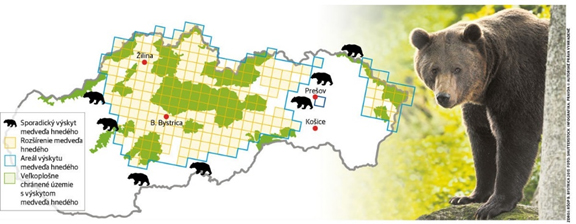Brown bear (Ursus arctos)
 Protection status
Protection status
Species of Community importance
Social value
5,000 €
Red List Category
LR/cd (Lower Risk: Conservation Dependent)
Biology
Our largest carnivore with a stocky body, short tail, small eyes and ears, strong legs with broad five-fingered paws with sharp claws and with dense 8–12 cm long fur. The fur colour is highly variable, ranging from grey-brown to black-brown. Juveniles have a white patch around their neck which fades as they grow older.
The body length of males can reach up to 2 m and the weight can be as high as 350 kg. Due to the so-called ipsilateral locomotion, the bear gives a somewhat clumsy impression, yet it can reach speeds of up to 50 km per hour when running.
A solitary lifestyle is typical for bears. They are active at dusk and at night. In bad weather and in spring (after they wake up from hibernation), bears are also active during the day. Towards the end of summer, they begin to build up fat reserves that they metabolise during hibernation. After hibernation, bears emerge from their dens and try to find mainly plant-based food, such as grass, leaves, needles, etc. Hibernation recovery takes some time and bears need a high protein intake during this period.
Ecology
In our territory, bears inhabit mountainous areas with coniferous and mixed forests. Bears are omnivores and consume green parts of plants, fruits, various invertebrates as well as vertebrates, especially smaller ones, but occasionally they also hunt hoofed game or search for carcasses. Plant food makes up 90% of their diet yet, interestingly, the bear can also be cannibalistic. Large males often attack young bears, which is an important method of natural regulation of bears.
If a bear changes its behaviour and starts looking for food around human dwellings, for various reasons, this is called synanthropisation.
A solitary male bear only accompanies a female bear at the time of oestrus. Bears mate from the end of May to the beginning of August, exceptionally later. Cubs are born after 7 – 9 months of latent gestation from late December to February, but the actual development of the embryo lasts only 8–10 weeks. Although the number of cubs per litter is most often 2, a female bear can have 1 to 4 cubs at once. The cubs stay with the mother until the age of three, when they become sexually mature. Females breed in a two- to three-year period. Bears living in the wild can live for 30 to 40 years.
Bear population distribution
The species can be found throughout the Holarctic region. In the Palaearctic region bears can be found on land in the area spanning from Western Europe to the Far East and Japan. On the British Isles bears are extinct, but they survived in Western Europe, the European part of Russia, China, Korea and southern Japan. In the Americas, bears can be found in northern Mexico, the Rocky Mountains, northern and north-western Canada and Alaska.
Distribution in Slovakia
Bears permanently inhabit mountainous areas of northern, central and north-eastern Slovakia.
 Legal protection
Legal protection
Internationally, the bear species is rare and threatened with extinction, and is therefore listed in EU legislation as a strictly protected species. Moreover, it is also protected by the Bern Convention. In Slovakia, the bear is listed as a protected species with a high social value and is protected under the Nature and Landscape Protection Act. The capturing, injuring or killing of bears is forbidden.
Sources:
ŽIAK, D. & URBAN, P., 2001: Červený zoznam cicavcov Slovenska (december 2001) – In: Baláž, D., Marhold, K. & Urban, P. eds., Červený zoznam rastlín a živočíchov Slovenska, Ochr. Prír. 20 (Suppl.): 154-156.
http://www.biomonitoring.sk/Registration/AtlasAnimal/Detail/49210?ReturnPage=oc_ZooGallery
Figures:
http://chkopolana.sopsr.sk/galeria/
https://spravy.pravda.sk/domace/clanok/435679-pocitanie-medvedov-a-vlkov-sa-zmenilo-na-chaos/
